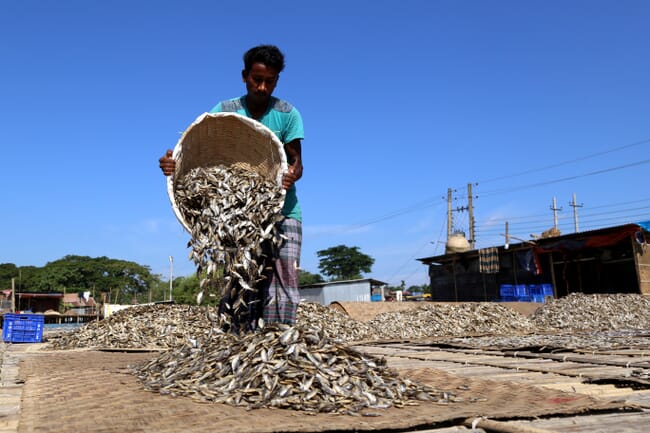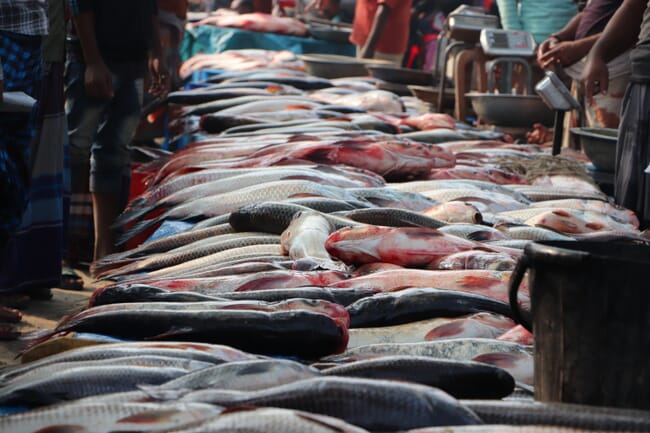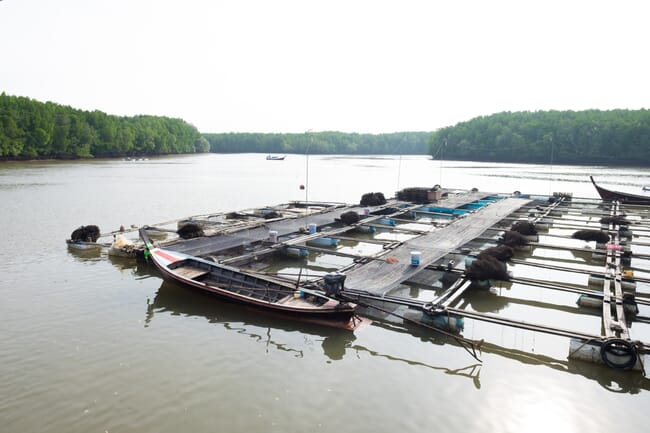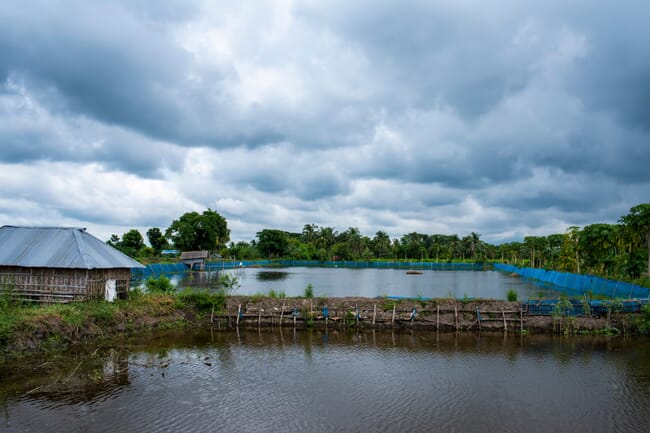So argue the authors of a recently published case study in Marine Policy, who have gathered data on Covid-19-realted challenges for Bangladesh’s aquaculture sector. The researchers found that the pandemic has squeezed each segment of the aquaculture supply chain but has exerted outsized pressures on finfish farmers.

Though it’s too soon to tell if the pandemic has thwarted the growth of Bangladesh’s aquaculture sector, the researchers recommend that the government makes strategic investments to keep farms Covid-safe and operational in the near term. The industry must also increase its processing capacity and transportation infrastructure to withstand future lockdowns.
How the pandemic impacted Bangladesh’s finfish sector
As the world locked down during the first wave of Covid-19 in the spring of 2020, many aquaculture activities were deemed “essential” and allowed to continue. Though primary production activities remained, the upheaval stemming from slowed cargo shipments and travel restrictions decreased overall fish production in Bangladesh.
One year into the pandemic, the finfish aquaculture industry is transitioning from the initial shocks of lockdown to a more stable footing – but whether Bangladesh can regain its status as a major aquaculture producer is far from certain.
To understand the full impact of Covid-19 on Bangladesh’s finfish farmers, the researchers conducted two online surveys in Mymensingh, a major aquaculture producing region. One was a structured questionnaire with 40 finfish producers that focused on the economic feasibility of farm activities during the pandemic. The researchers also surveyed 120 middlemen (aratdar) and 120 consumers to learn about the impact of Covid-19 on the aquaculture supply chain and on consumer choices.

Initial analysis shows that the national lockdown reduced aquaculture productivity, put a strain on transport links, caused a spike in unemployment and, consequently, decreased disposable incomes for families in Bangladesh. For aquaculture producers specifically, the pandemic has made farm operating costs surge while squeezing profit margins. It has also made existing inequalities in the supply chain more deeply entrenched.
The lockdown shortened the aquaculture supply chain significantly. Many of the aratdar who sold fish from rural farms to urban centres have left the market entirely, while local middlemen gained a foothold. Despite this shift, the researchers found that many aratdar are purchasing fish at depressed prices at the farm gate, but increasing their selling prices to retailers, presumably to offset increased costs and to make up for sluggish demand. This is making it harder for finfish farmers to break even.
Since prices for popular fish like pangasius and carp increased alongside a spike in unemployment, demand for these fish dropped. However, prices for tilapia and catfish have decreased slightly. The researchers noted that many consumers with reduced incomes switched their main source of protein from fish to eggs. For those who continued to eat fish, many switched their preferred species from pangasius to tilapia, which is usually cheaper.
The farm survey revealed that a larger-than-expected portion of farm expenditures are going to aquafeed and medicinal treatments for the fish. Since many transport and processing operations went offline during the pandemic, farmers held on to market-ready fish, anticipating the return of these services. However, these industries have not recovered to their pre-pandemic levels. This means that farmers are spending their available money on keeping slaughter-weight fish healthy instead of investing in the next production cycle.
The survey also showed that farmers are compensating for rising operational costs by cutting farm labour – usually by furloughing staff numbers and substituting higher-waged staff with lower-paid temporary workers. Though this can keep farms afloat short term, the researchers warn that these practices risk frustrating the communities that fish farms operate in.
How can the finfish sector bounce back from Covid-19?
The researchers pitched multiple strategies to stabilise Bangladesh’s finfish farming industry. In the short term, they argue that the Department of Fisheries should promote Covid-secure working practices on farm sites to prevent further outbreaks. They suggested developing a smartphone app that provides farmers with information on safe working practices.

The Department of Fisheries could also try to make farmers aware of “compensatory feeding” to keep feed costs under control. In this system, fish are fed in short, intermittent spells, which increases their growth rates. This strategy will let farmers to maintain their fish stocks in case lockdown measures impact the transportation and processing links of the aquaculture supply chain.
The researchers also recommended giving farmers access to interest-free bridging loans to stay in the black. The practice has been trialled successfully in the United Kingdom, Canada and Switzerland, and allowed aquaculture producers to pay wages and maintain business operations during the downturn. The bridging loans would also ensure that farmers could set up new production cycles next year to avoid further market disruptions.
In the medium term, they argue that farmers should consider switching to polyculture operations instead of farming a single species. Ideally, producers could culture indigenous carp species alongside pangasius and tilapia. The researchers explained that this would make the sector more resilient since farmers would be less dependent on high value imported feed and would be able to withstand market fluctuations.

The researchers also suggest developing digital services that would link consumers with their local finfish farmers. Creating an online payment service would allow contactless (and therefore, Covid-safe) purchases, shorten the supply chain and provide product provenance for the consumer.
Moving beyond the pandemic
Long-term, Bangladesh’s finfish farmers need to become more organised and gain an active voice in government decisions. Though aquaculture is a key export commodity and a valuable source of foreign earnings, Bangladesh’s fish and shrimp farmers are largely unorganised and there is no industry-wide association that represents their interests. A farmer-led group could ensure that government decisions are made with their input, and also ensure that any government stimulus is distributed fairly among its members.
In addition to creating a formal farmers’ association, Bangladesh should invest in market monitoring and regulation for the aquaculture industry. The researchers believe that this would stabilise the market and, “allow a roadmap to ensure a sustainable future for the industry delivering the right balance of species for the consumer and production markets.”
The government should also provide financial incentives or pursue public-private partnerships to develop local finfish processing companies. This would not only provide stable livelihoods, but also add value to Bangladesh’s aquaculture outputs and improve the quality of the finished products. Implementing these measures could put the Bangladeshi aquaculture sector in a stronger position for the rest of the 2020s, they conclude.




